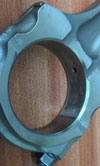Small end lubrication (2)
 In last month's article on connecting rods, I looked at a common way of providing lubrication to the small end of the connecting rod - drilling (or multiple drillings) into the small end of the rod. In many cases this is enough to supply lubrication of the small end. But there are many cases where this might prove inadequate.
In last month's article on connecting rods, I looked at a common way of providing lubrication to the small end of the connecting rod - drilling (or multiple drillings) into the small end of the rod. In many cases this is enough to supply lubrication of the small end. But there are many cases where this might prove inadequate.
The oil entering the small end via these radial drillings has to find its way into the entry of the drilling (hence the generous chamfer provided), and the source of the oil may in some cases be only oil 'mist' as the result of splash lubrication. In racing engines with dry sumps and higher power outputs, it is quite likely that piston spray jets will be provided to take heat from the piston. In this case there will be a lot of oil in the vicinity of the small end.
Sometimes this will be a single spray jet, but some modern racing engines can have up to ten spray jets per piston, some of which are aimed specifically toward the small end of the rod. The recent trend towards stiffer pistons and the 'box-bridge' design, however, means there is some obstruction to oil flow aimed in the vicinity of the small end.
In this case, and others where there are extreme bearing stresses, there is a case for providing positive lubrication of the small end - that is, a specific and pressurised oil feed. Highly supercharged engines are a good example of an application where positive lubrication is often provided.
The oil flow to the small end is via a drilling from the big end of the rod. The photo here shows a connecting rod that has a drilling for this purpose.
Oil arriving at the crankpin via the crankshaft oil drillings is fed onto the outside of the bearing shell via a drilling through the shell itself. The hole may connect directly with the drilling up through the connecting rod, in which case the hole in the shell will be vertically upward. Some people are wary of having a drilling at this position in the big end shell, however, so they might therefore choose to provide a slot or cavity to carry oil to the drilling from a hole which they perceive or calculate to be at a more advantageous point in the shell.
If you choose this route you have to make sure the bearing itself has enough support, especially if it is a thin bearing. The trend toward thinner big-end bearing shells makes it more important to support the bearing in a stiff housing.
If you're designing a bespoke rod you may have to carry out a lot of FEA analysis or physical design iterations before arriving at a suitably stiff housing design. Taking away material from the surface of the housing means this part of the bearing may deflect under load and therefore not play its proper part in supporting the forces in question. This leads to higher bearing stresses on the rest of the bearing and therefore may overload these areas, causing premature failure.
Fig. 1 - A con-rod with a drilling from the big end to provide oil flow
Written by Wayne Ward